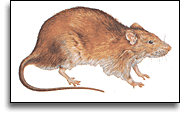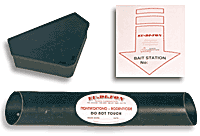 House
mice should not be confused with young rats. The mouse's head and feet are
in proportion to its body. House mice are extremely prolific breeders.
House
mice should not be confused with young rats. The mouse's head and feet are
in proportion to its body. House mice are extremely prolific breeders.At 35 days of age they mature and carry embryos for 18 - 21 days. If a female aborts, she can become pregnant again within 48 hours. The average litter size is about six. Variation in genetics, food supply and temperatures can affect these numbers. A female suckles her young for about four weeks. The female may become pregnant following parturition or while lactating. Therefore if all goes well, a female can have litters approximately every 40 - 50 days. Under optimum conditions (often found indoors) mice can breed through the year. Newborn mice are extremely small, pink and naked. After about three weeks they are fully covered with hair, make short trips from the nest and begin feeding on solid food. Mice usually live for 15 - 18 months.
 The
Norway rat is the most common of rats and occurs practically everywhere.
The roof rat is found commonly in sea ports and is also a house rat.
The
Norway rat is the most common of rats and occurs practically everywhere.
The roof rat is found commonly in sea ports and is also a house rat.The life of rats in a population is about six months.
 Rats
and mice have rather poor vision and are colorblind, but the sense of smell,
taste, hearing and touch are keenly developed. They usually become active
half an hour after dusk, after the premises have become quiet. When unmolested,
rats roam about seeking food during any part of the day or night.
Rats
and mice have rather poor vision and are colorblind, but the sense of smell,
taste, hearing and touch are keenly developed. They usually become active
half an hour after dusk, after the premises have become quiet. When unmolested,
rats roam about seeking food during any part of the day or night. One of the favorite nesting places for rats in buildings is the closed space under the building ground floor. All other closed spaces of buildings may be utilized by rats if they can gain access to them. Nests will often be found in piles of rubbish and merchandise if the latter is stored over a month without being moved. In residential areas they live outdoors in yards, garages, sheds and in sewers. They also dig the earth in the tunnels with their front feet and shove the loose soil back under their belly. They can also run, climb, jump and swim.
Disease organisms may be transmitted either directly through the rodent's bite or carried from the rodent to a flea, tick or mite, which bites man and transfers the pathogen, or by contaminating food or water with their dung or urine (plague, murine typhus fever, leptospirosis - trichinosis - food poisoning)
- The exterior of those parts of the structure accessible to rats, including
porches or other appurtenances, must be constructed of materials resistant
to the gnawing of rats, and all openings must be either permanently closed
or protected with doors, gratings or screens.
- The interior of the building must provide no dead spaces, such as double walls, spaces between ceiling and floor, staircases, and boxed-in piping, or any places where a rat might find safe harborage, unless they are permanently sealed with impervious materials.
 A
complete rodentification program must be applied for successful elimination.
Recognition of runways, nests and burrows is very important. Useful tools
such as anticoagulant rodenticide are available. Glue boards, snap traps
and ultrasonic devices are available but less effective in heavy infestation.
A
complete rodentification program must be applied for successful elimination.
Recognition of runways, nests and burrows is very important. Useful tools
such as anticoagulant rodenticide are available. Glue boards, snap traps
and ultrasonic devices are available but less effective in heavy infestation.